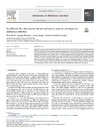Identificador persistente para citar o vincular este elemento:
https://accedacris.ulpgc.es/jspui/handle/10553/55761
| Campo DC | Valor | idioma |
|---|---|---|
| dc.contributor.author | Warsi, Firoz | en_US |
| dc.contributor.author | Khanam, Ruqaiya | en_US |
| dc.contributor.author | Kamya, Suraj | en_US |
| dc.contributor.author | Suárez Araujo, Carmen Paz | en_US |
| dc.date.accessioned | 2019-06-11T12:59:48Z | - |
| dc.date.available | 2019-06-11T12:59:48Z | - |
| dc.date.issued | 2019 | en_US |
| dc.identifier.issn | 2352-9148 | en_US |
| dc.identifier.uri | https://accedacris.ulpgc.es/handle/10553/55761 | - |
| dc.description.abstract | Malignant melanoma is the deadliest form of skin cancer, but can be more readily treated successfully if detected in its early stages. Due to the increasing incidence of melanoma, research in the field of autonomous melanoma detection has accelerated. In this paper, a new method for feature extraction from dermoscopic images, termed multi-direction 3D color-texture feature (CTF), is proposed, and detection is performed using a back propagation multilayer neural network (NN) classifier. The proposed method is tested on the PH 2 dataset (publicly available) in terms of accuracy, sensitivity, and specificity. The extracted combined CTF is fairly discriminative. When it is input and tested in a neural network classifier that is provided, encouraging results are obtained, i.e. accuracy = 97.5%, sensitivity = 98.1% and specificity = 93.84%. Comparative result analyses with other methods are also discussed, and the results are also improved over benchmarking results for the PH2 dataset. | en_US |
| dc.language | eng | en_US |
| dc.relation.ispartof | Informatics in Medicine Unlocked | en_US |
| dc.source | Informatics in Medicine Unlocked [ISSN 2352-9148], v. 17 (2019), 100176 | en_US |
| dc.subject | 120304 Inteligencia artificial | en_US |
| dc.subject | 32 Ciencias médicas | en_US |
| dc.subject | 220990 Tratamiento digital. Imágenes | en_US |
| dc.subject.other | Melanoma | en_US |
| dc.subject.other | Color texturefeature | en_US |
| dc.subject.other | Dermoscopic image | en_US |
| dc.subject.other | Neural network classifier and skin cancer | en_US |
| dc.title | An efficient 3D color-texture feature and neural network technique for melanoma detection | en_US |
| dc.type | info:eu-repo/semantics/article | en_US |
| dc.type | Article | es |
| dc.identifier.doi | 10.1016/j.imu.2019.100176 | |
| dc.identifier.scopus | 85064884216 | |
| dc.contributor.orcid | #NODATA# | - |
| dc.contributor.orcid | #NODATA# | - |
| dc.contributor.orcid | #NODATA# | - |
| dc.contributor.orcid | #NODATA# | - |
| dc.contributor.authorscopusid | 57208467728 | |
| dc.contributor.authorscopusid | 56785943200 | |
| dc.contributor.authorscopusid | 56126551300 | |
| dc.contributor.authorscopusid | 6603605708 | |
| dc.description.firstpage | 100176 | - |
| dc.investigacion | Ingeniería y Arquitectura | en_US |
| dc.type2 | Artículo | en_US |
| dc.utils.revision | Sí | en_US |
| dc.identifier.ulpgc | Sí | es |
| dc.description.sjr | 0,363 | |
| dc.description.sjrq | Q3 | |
| item.grantfulltext | open | - |
| item.fulltext | Con texto completo | - |
| crisitem.author.dept | GIR IUCES: Computación inteligente, percepción y big data | - |
| crisitem.author.dept | IU de Cibernética, Empresa y Sociedad (IUCES) | - |
| crisitem.author.dept | Departamento de Informática y Sistemas | - |
| crisitem.author.orcid | 0000-0002-8826-0899 | - |
| crisitem.author.parentorg | IU de Cibernética, Empresa y Sociedad (IUCES) | - |
| crisitem.author.fullName | Suárez Araujo, Carmen Paz | - |
| Colección: | Artículos | |
Citas SCOPUSTM
44
actualizado el 08-jun-2025
Visitas
211
actualizado el 27-sep-2025
Descargas
239
actualizado el 27-sep-2025
Google ScholarTM
Verifica
Altmetric
Comparte
Exporta metadatos
Los elementos en ULPGC accedaCRIS están protegidos por derechos de autor con todos los derechos reservados, a menos que se indique lo contrario.
